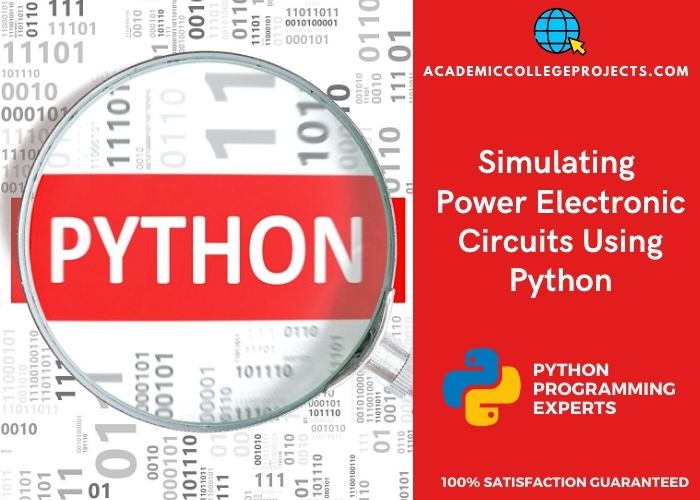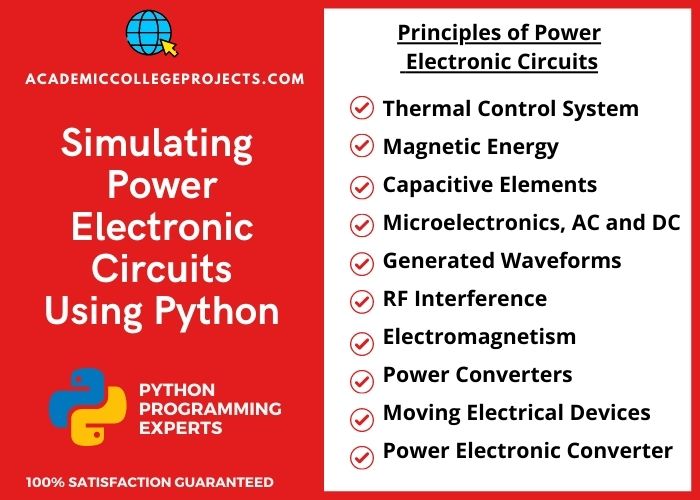In simple words, power electronics is defined as the effective conversion of electrical energy into different forms for better resource utilization. Specifically, power electronics help you to study the electrical, electronics, and control systems that work on power energy. Further, it can be analysed by various aspects as capabilities, determination, physics, drive requirements, features, and security. If you are searching for assistance to implement Simulating Power Electronic Circuits Using Python, reach our expert panel team.
Principles of Power Electronic Circuits
- Thermal Control System
- Magnetic Energy and Capacitive Elements
- Microelectronics, AC and DC
- Quality Assessment of Generated Waveforms
- RF Interference and Electromagnetism
- Advance Control Schemes for Power Converters
- Fixed and Dynamic Moving Electrical Devices
- Topologies of Power Electronic Converter
As beginners, both electrical engineers and students may undergo challenges in developing and simulating electrical circuits. If the task is related to non-linear-based circuits, then the complexity will be more for developers. To make all these processes easy, the python tool will be preferred which will be discussed upcoming section. From a subjective point of view, the power electronics course covers fundamental theories of circuit simulation. This simulation helps you to realize in what way the power converters work.
In real-world scenarios, power electronics is a vast field to support most important problems like mobility, weather condition variation, etc. More than the simulation infrastructure, it is also necessary to consider government norms that create a major impact on future power electronics transformation.

Simulating Power Electronic Circuits using Python Programming
As mentioned earlier, Python has all the required technical support for simulating power electronics projects. Since simulation is the most important process for learning the workability of power electronics and electrical drives. Through this, you can analyze the behaviour and performance of the electronic circuits and power systems at dynamic varying scenarios. Particularly, students get more benefited to learn the electronic concepts in practical implementation.
Similarly, it is also helpful to budding electronic engineers to enhance their technical skills. For instance: electronic engineers can easily handle microcontroller programming. Same as python, C and assembly languages are also largely employed for microcontrollers. Relatively, python is more developer-friendly to code complex logic for algorithms.
Role of Python in Power Electronics
In fact, python is a general-purpose open-source tool that supports circuit simulation for power electronics projects. The main aim of this tool is to provide a sophisticated platform for simulating large systems using several power converters.
The modules and libraries are developed using python language for free distribution. Generally, the power electronics projects involve more usage of complex mathematical functions. Python makes this complicated task into an easy one by providing in-built pre-defined functions for students’ benefit. So it is easy to learn and analyze generated waveforms from power circuits. And, it provides an animation tool to display the simulation of electrical machine workflow and functionalities.
What is the purpose of using Python for power electronics projects?
- Easy to freely download the software
- Simple to learn and code the program
- Comprises vector and raster formatted hardcopy
- Enable to design, analyze and develop model quickly
- Support both circuit and equation based applications
- Provide GUI-based environ for user-friendliness
- Flexible to work with any OS such as Windows, Mac and Linux
- Make students to easily work with complex mathematics and understand transient waveforms with spectra, means and RMS values
- Provisioned with different graphic resolutions which 800×600 is minimum
- Use only minimum memory (disk space – ~150 to 200 MB and RAM – above 1MB)
How does power electronics simulation works in python?
As a matter of fact, python supports a huge volume of differential equations to solve the problems sequentially and mathematically. Our developers are proficient to handle all significant and newly emerged packages of python. So, we are capable to support you in simulating power electronic circuits using python regardless of complexity. Here, we have given you the simulation procedure of power electronics systems for your reference.
- Initially, design the circuit topology and define the equations required for power electronics devices
- Then, load and set the following device parameters and use semiconductors as switches
- Number of Choppers
- Electric Device Strategies
- Control System Fundamentals
- Electronic Power Circuit Basics
- Electronic Energies and Control Essentials
- Controlled / Uncontrolled Electric Configurations
- Next, compute the preliminary conditions of semiconductor. If the computation is not accurate then the transient simulation interval will occur and affect the results
- After run the simulation and verify the semiconductor conditions in every step. In this, new equations are formed to initiate the outcome based on previous step
- Finally, the simulation ends only when the final conditions are matched
Once the simulation environment was constructed with proper settings, then numerous experiments will be conducted to examine performance at new relevant data arrival. Here, we have given your logic for examination.
- When the transition event happens, the output matrix makes a record of past and post values. For triggering storage, magnitude states are used
- When the storage condition is satisfied, then the timeout condition will be initiated for next storage
- The time array used in the output matrix is intended to compute the RMS and average values
- Further, the python subfolders are equipped with simulation modules which are developed by python GUI-based numerical libraries
Specifically, python provides electronic modules to develop schematic arrays, solve math problems, and simulate circuits. Our developers are adept to work with any kind of complex numerical operations to solve the complexity of code developments. So, we are familiarized to handle the majority of electronic modules of python. For your information, here we have included other modules that support power electronics engineering.
Python Packages for Power Electronics
- Matplotlib
- Installation Command – pip install matplotlib
- Utilize python code to perform mathematical and engineering operations
- Able to integrate Juypter Notebook specially for simple documentation
- SKiDL
- Installation Command – pip install skidl
- General python objects used to connect pins, verify errors and instantiate entities
- PCB is used to create schematic environ
- SKiDL support complex design which incorporates multi-ASICs
- PySpice
- Installation Command – pip install pyspice
- Used to develop interface for circuit simulators
- For instancs: Xyce or Ngspice
- Also, it is used in Falsted Simulator
- For instance: xyce, Quacs, KiCad, LTSpice, ngspice
- Pint
- Installation Command – pip install pint
- Works on the basis of physics disciplines
- For instance: Operating on physical and electronic quantities (Ohm’s law Computation)
- Jupyter Notebook
- Installation Command – pip install jupyter
- Used to make notebook pages using binary objects, rich-text and code of python
- In this, single in-line page represent the code for testing
- Further, it can integrate with other libraries. For instance: matplotlib
- NumPy
- Installation Command – pip install numpy
- Introduced for performing numerical operations in Math
- Used to save generic information in database (multiple-dimensional container)
In addition, we have given you the libraries for simulating power electronic circuits using python. Similar to modules, we have skillful to recognize and import required libraries based on the project requirements. Since each library has some special functions to handle specific power electronic operations. So, our experts are precise to identify appropriate libraries based on your handpicked project concepts.
Python Library for Power Electronics
- ElectricPy
- Support large functions and constants which mainly used for electrical engineering
- Applicable for learning, research, development of electrical engineering
- mpi4py
- Used for developing and executing MPI
- Support OOPs concept for Message Passing (for MPI-2 C++ bindings)
- Able to develop application using MPI syntax and MPI-2 bindings semantics (C++ to Python)
- htcsim
- Used for simulating multiple scenarios simultaneously
- Enable to stable the workload between parallel practices
- Other open-source software – OMPython and OpenModelica
From the above list, here we have selected the “electricpy” library for illustration purposes. In this, we have given the installation procedure of the electricpy library with their supportive dependencies. Further, we have also included the python documentation and installation verification command. In fact, we usually give software installation procedures with software download links for every project at the time of project delivery for the benefit of our handhold students/scholars.
INSTALLATION Procedure for ElectricPy
- Installation of Essential Dependencies
- Package Installation Command
- pip install scipy
- pip install sympy
- pip install numpy
- pip install numdifftools
- pip install matplotlib
- Package Installation Command
- Installation of ElectricPy
- Method 1 – Install electricpy using Python’s pip
- Package Installation Command
- pip install electricpy
- Package Installation Command
- Method 2 – Install electricpy using Source
- Method 1 – Install electricpy using Python’s pip
- Python Documentation (Get Repository and Install)
- Using GitHub Repository, collect clone or download source code
- Type the commands in Terminal
- cd <path\to\containing\folder>\electricpy
- Use Python to install required module
- python setup.py install
- Validation of Installation
- Verify the success state of installation using python
- import electricpy
- electricpy._version_
- Verify the success state of installation using python
So far, we have completely seen about requirements and importance of simulating power electronic circuits using python. In specifically, we have also seen the simulation procedure, python packages, libraries, and package installation procedure. Now, we can the significant research areas of power electronics. All these areas provide an extensive range of innovative project ideas with long-lasting future study scope. If you are interested, then we are ready to share our innovative project ideas from below and other emerging areas.
Latest Research Topics in Power Electronics
- Actuators and Engines
- Secure Connected Power Systems
- Sensors and Transducers
- Renewable Energy Storage
- New Energy Model Developments
- Large Industry Thermal Control
- Electric Drives Control Strategies
- Energy Emission Control Schemes
- Low and High Power Electric Converters
- Smart Grids-based Power Engineering
- Electronic Engineering in Power Systems
- Power Converters and Semiconductors
- Smart Transportation System
- Power Quality Assessment in EMC
- System Robustness and Reliability
- Motion Control in Automated Machines
- Energy-Aware Passive Machineries
- Interrelated Materials and Reliable Packaging
- Power Electronic Simulation Tools Design
For your information, here we have given you another set of software installation tools for the simulation of power electronics projects. For instance:
- Simplorer
- Matlab/Simulink
- SABER
- EMTP (or EMTDC)
- PSIM
- PSPICE and more
Here, some of the tools support python and others may FORTRAN or C. To the end, we are glad to inform you that we support you in all current and future research areas of power electronics with their supporting fields. Once you make a contact with us, we are ready to share our novel project topics which cover implementation process of simulating power electronic circuits using python programming.


